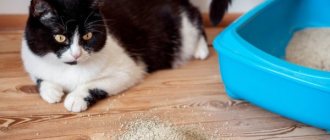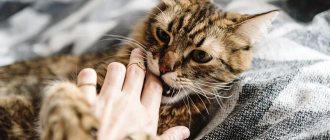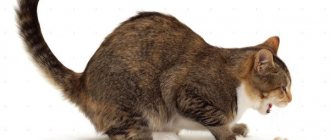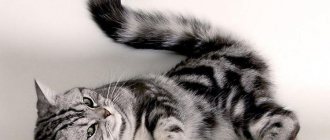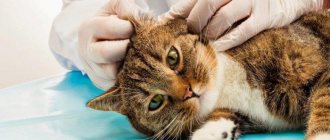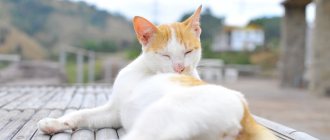The need for cat grooming - pros and cons
Most often, the need to groom a cat is due to the numerous tangles that have formed on the animal’s body due to lack of proper care. There are stories when tramps picked up from the street were found to have numerous ulcers, sores, worm eggs, external parasites and their larvae under matted hair.
In the case of weeping ulcers and lichen, the pet must be frequently treated with medicinal ointments and compositions, and it can be difficult to reach the skin through the hair.
In addition, with abundant tangles, the cat’s skin tightens, and the animal experiences unpleasant and even painful sensations. Sometimes it becomes necessary to trim your pet due to too many hairballs forming in the gastrointestinal tract, which can cause serious diseases of the digestive system.
Another common argument from owners in favor of this procedure is that the climate is too hot. Constant temperatures above +35 °C are usually difficult for animals to tolerate.
We recommend reading the article about grooming cats.
Often in breeds with special coats, the hair around the anus and genitals becomes very dirty when using the litter box. Of course, you can often wash your pet or trim problem areas, but the aesthetics of the appearance suffer. Read the article about long-haired breeds.
Sometimes you have to resort to cutting due to heavy shedding, when the whole house is littered with hairballs. This is especially true if there are small children or people with allergies in the apartment. But as a rule, the seasonal change of coat passes quickly, and in other cases you should be concerned about the health of the animal and consult a veterinarian. Severe hair loss in a cat can be caused by a lack or excess of vitamins in the diet, or some other pathologies.
Sometimes owners of older animals groom their cats because it is difficult for them to care for their fur themselves.
Many owners prefer aesthetic rather than hygienic haircuts, which give their pet a well-groomed and even glamorous look. Thus, the benefits of grooming cats in many cases are undeniable; grooming often transforms the most homely pet.
In any case, before deciding to groom a cat, the owner should also think about the negative side:
- To one degree or another, the thermoregulation of the cat’s body is necessarily disrupted, because the skin’s natural breathing process is rudely interfered with.
- Some experts believe that cat hair that grows back after being trimmed is of poorer quality.
- These animals usually do not tolerate the procedure itself well and often become depressed and fall ill. There are even isolated cases of a pet dying during a haircut due to heart failure. Read about stress in cats.
- After removing the fur with a clipper or scissors, the cat's hair, as a rule, grows back very slowly and does not always return to its previous length.
- In the first days after cutting, the hairs are very prickly and cause inconvenience to both the animal and the person.
In principle, if the animal is healthy, then it does not need a haircut under any circumstances. Cats groom themselves very often, almost constantly, which provides excellent coat care. Regular brushing will also help. Read the article about how to comb cats and kittens correctly.
When licking, cats realize many instincts - they evenly distribute and lick their own scent, calm down, and relieve stress.
The condition of the skin and coat are the main signs of a pet’s health. At the first symptoms of dull hair, the owner should reconsider the cat’s diet and not grab the scissors.
It must be remembered that grooming a cat is not the norm, it is a radical measure, permissible in case of urgent need - skin diseases and abundant mats. In all other cases, this procedure is not mandatory.
New fashion trend or necessity? You will learn all the intricacies of haircuts and care first-hand from Daria Karabet, an experienced groomer who works with cats and dogs every day and knows all the intricacies of caring for the finicky fur of pets.
Daria, where did it all start?
Throughout my adulthood, I asked my parents for a dog, I remember it very well, from the age of 5.
There were many reasons why I was refused, but I still consider them not significant. At the age of 18, I bought my first dog, a Russian hunting spaniel mix, and once I took her for a haircut, I asked myself, “why don’t I do it myself?” Soon, having secured the financial support of my dad, I went to study to become a “dog and cat hairdresser.”
And my love for cats was discovered later, when I left my father’s house at the age of 20 and began to live with dogs. I accidentally came across an animal aid society and it started, I didn’t take dogs for foster care, the apartment didn’t allow it, but in 2 years more than 30 cats passed through my hands. And among this abundance there was him, the chic Persian man Domino, battered by life. After it, I realized that life is not the same without a cat!
Domino. It was with him that Daria's love for cats began
The start of my activity was the courses at the groomroom , now it no longer exists. I gleaned a lot of information from the Internet, got my head around it, went to master classes with the guru, and still attend them to this day. And after five years of active work, she began to conduct individual training herself, this difficult, but terribly exciting profession. And in 2 years I slowly trained more than 10 groomers (*smiles).
At what age can you start grooming your pet?
The answer to this question is very comprehensive, because first of all, it depends on the breed or characteristics of the pet. If we talk about cats, they don’t have any mandatory haircuts, but there are haircuts that can make caring for your pet easier. In any case, it is better not to cut kittens until six months of age, but to devote this time to vaccinations, quarantine and love.
Photos before and after haircuts and treatments
Is it true that grooming pedigree cats ruins their fur?
Yes, there are breeds for which cutting is not recommended and can lead to a deterioration in the quality of the coat. For example, a chic make-up, after a haircut, may not grow any more hair, but will only have one fluff. But there is also no guarantee that a mongrel cat will grow back everything the same as before. Often, the fur does not deteriorate and grows beautifully, even in purebred cats.
How often should cats be washed?
If the cat does not leave the house, and the owner does not forget to brush it regularly, then it is enough to wash the pet once every three months. How often should you wash a cat walking in the yard? If the family lives near a road or railway, then once every one and a half to two months, if the surrounding countryside is three to five times a year. Hairless cats are bathed most often - once every two weeks in the summer, once a month in the winter. Professional shampoos for washing cats allow you to carry out bathing procedures at least every month, maintaining the fur coat in perfect condition, without drying out the skin and fur.
And if a cat is very worried during the procedures and does not even allow his claws to be trimmed calmly, is it possible to give such an animal a haircut?
For such cats, in the majority, grooming salons were invented, because a cat is a territorial animal and, often, when losing its territory, falls into a state of stupor, which is simply ideal. (*smiles) However, usually this time is limited and amounts to no more 20 minutes.
Is getting a haircut too stressful?
If the animal is healthy and not old, then the stress will be insignificant. Also, owners can independently reduce the impact of stress, for example, by pre-giving them a light sedative (note: the drug cat bayun). It is not recommended to carry out a haircut at home - this will undermine the cat’s sense of security, because his home is his fortress. The ideal formula is to start light sedatives 2 weeks in advance, do not feed on the day of the haircut, a haircut in the salon for no more than half an hour, and upon arrival home, if possible, give the cat peace and something tasty.
another pet with a new look
How often should cats be groomed? And how to maintain the beauty of a haircut at home (maybe even out the cheeks or something else)?
First of all, you need to cut your hair with understanding! After all, it is not uncommon for owners to get rid of part of the skin out of good intentions to “remove mats”...
And to maintain beauty, often no additional care is required. This is due to the fact that professional haircutters adjust the boundaries of haircuts and the hair grows evenly without spoiling the overall shape. About the frequency of haircuts: for long-haired cats once every six months, for smooth-haired cats (to avoid shedding) 3-4 times a year.
Why don't cats have their entire head and tail cut (to the same length as the fur on their body)?
The tail is not cut to avoid neuroses; many cats do not perceive this part of the body as their own, and when the tail suddenly remains completely bare, some begin to gnaw it hysterically. The head is not cut, so as not to damage the whiskers and not to decoordinate the pet, also the hair on the head grows extremely slowly and we can get the result - a cat with a hairy body and a head that has not yet grown, and this is not at all aesthetically pleasing (*laughs).
Can my pet become infected with something during a visit to the salon?
No, this is impossible! All instruments are soaked in a disinfectant solution and stored in a special ultraviolet cabinet. Tables and bathrooms are also disinfected.
photo before haircut
and immediately after
Of course, we cannot ignore personal issues; it is very interesting to take a glimpse into the life of a groomer. How does your family feel about your work, do your friends support you, or do they, on the contrary, consider it something not serious?
Even 6-7 years ago, when I said: “I’m a groomer,” I was met with blank looks, bewilderment on their faces and grins. Nobody considered my business serious; the science of grooming cats and dogs is not great! Now they take me more seriously, because for many people going to the groomer is already a routine matter. Mom was skeptical about this and believed that the profession should be respected, so that people would only address me as “you” and “Daria Anatolyevna,” and dad always supported me and believed that you can become a “man of action” in any profession. My husband, when we met, didn’t pay much attention to who I worked for; his friends often thought I was some kind of fool with a bunch of dogs and cats (*smiles).
Now they all also have pets and the skepticism has passed.
What can you wish for housewives for caring for their pets' hair at home?
The best thing you can do for hair care, no matter how trite it may sound, is proper nutrition . And for long-haired cats: comb them regularly with a metal comb; during the heating season, moisturize the fur with special sprays to avoid dryness and the formation of tangles. If you can’t handle the wool, it’s ideal to cut it twice a year – April/May and October/November, at the beginning of the heating season. And, of course, don’t forget to wash.
Short-haired cats can be combed with a special rubber glove or a furminator, but without fanaticism. And wash it too.
But for the owners of bald cats, there is one truth - there is nothing better than a clean cat, lightly steamed and scrubbed!
In the comments you can leave your questions regarding cat grooming, we and Daria Karabet will definitely answer you!
Daria Karabet answered questions especially for Meow Gallery
TopGroom
Ekaterinburg, st. Shcherbakova 3 b (entrance through the “Reserve” store)
You can make an appointment by phone: +7 (343) 382-49-52 or (Viber WhatsApp WeChat only)
Breeds that often need grooming
Typically, cats of semi- and long-haired breeds suffer the most from matting and the formation of tangles. Even if you miss even one brushing, for example, of a Persian, problems will definitely arise. The animal's blood circulation is impaired due to skin tightness, it becomes nervous, experiences discomfort and itching.
Read the article about why a cat can scratch itself until it hurts.
Therefore, most often, haircuts to remove tangles are used for:
- Kurilian bobtails;
- Neva Masquerade;
- Maine Coons;
- Norwegian forest;
- Siberian;
- Turkish Angoras;
- Persian;
- ragdolls.
It should be remembered that Persians have hair in the undercoat and the main coat of the same length, and cutting for this truly long-haired breed does not disrupt heat exchange. Therefore, the grooming procedure is not dangerous for their health. But the semi-long-haired Maine Coon, Siberian and Norwegian forest cats have axial and undercoat hair of different lengths. Due to this, a layer of air is naturally created, protecting the pet from overheating and excessive cooling.
The texture and structure of the hairs here are also different, so cutting these breeds must be done very carefully and only as a last resort.
Short-haired breeds usually do not require trimming at all. The only exception is the British.
It is easier to prevent the formation of tangles than to cut them off later, ruining the aesthetic appearance of your pet. Moreover, you should not subject him to a more beautiful general haircut, disrupting the heat exchange of the skin and causing unnecessary risks to the cat’s health.
Necessary accessories and preparation for a haircut
If, nevertheless, there is an urgent need to groom a cat, but the owner is afraid of injuring the pet and is not sure that he can cope with the procedure, you can contact grooming specialists in a professional salon. This operation is also included in the price list of many veterinary clinics.
In case of self-grooming at home, the animal owner must first purchase the necessary tools and equipment and perform certain actions:
- Prepare a table or wide ironing board as a grooming area.
- Buy large and small scissors with rounded tips and sharp blades made of high-quality steel, a furminator.
- Choose and buy a trimmer - a special machine for cutting animals. The optimal nozzle for cats is usually 3 mm. The device cannot be used on human hair, as cats have a completely different hair structure. You also need to decide on the power of the device, so for Persians it needs high (45-60 W), for semi-long-haired pets you can limit yourself to 20 W.
- Make sure there is minimal stress for the cat. Thus, more powerful rotary trimmers make a lot of noise and frighten the animal; it is worth choosing a model with a mains adapter and a vibration-type motor.
- The cat may need to be given sedatives the day before the procedure. It should be remembered that synthetic substances and anesthesia will harm your pet; it is better to use herbal products.
- Sometimes it is advisable to use an Elizabethan collar - a special device worn around the animal’s neck. It can prevent a nervous cat from biting and injuring the groomer. A special muzzle can also help - a cap that covers the cat’s mouth and eyes.
- Most likely, you will need a special machine for cutting hair on the paw pads, face, around the genitals, and in other hard-to-reach places.
- It is necessary to provide thinning scissors and a massage brush to bring the hairstyle to its final shine. Also, for some (especially short-haired breeds) cats, you will need velvet for polishing, wet wipes to remove excess hair, or a special glove.
- It is also worth making sure that you have on hand the means to provide first aid to your pet if an accidental injury to the skin occurs. It is better not to use alcohol-containing compounds (iodine), but to purchase hydrogen peroxide, Miramistin, Chlorhexidine, and special talc.
You should invite another person as an assistant, and the pet itself should have its claws trimmed at least 24 hours in advance.
How to restore and improve the quality of a cat's fur?
Rapid deterioration of the coat, combined with weight loss, decreased activity and appetite, is a reason to contact a veterinary clinic. In other cases, it is enough to take into account the following points:
- preparing an adequate diet . If the cat eats homemade food, the basis of the menu should be boiled meat (beef, poultry), fermented milk products, as well as rice, oatmeal, and wheat porridge (meat/cereal ratio is two to one). Once a week you can give lean fish, twice - boiled egg yolk. Every day you can add up to 2 teaspoons of vegetable oil, dill, parsley, oat/wheat sprouts to your food. When choosing a complete food, it is better to give preference to premium products that have special recipes for kittens, elderly and sterilized pets. Having found the “right” diet or food, it should be adhered to throughout the cat’s life;
- refusal of “delicacies” from the table . Fatty and fried, salty and pickled delicacies, flour, sweets will not benefit the health, and therefore the appearance of the animal. And food additives can cause allergies of varying degrees;
- compensation for vitamin and mineral deficiency . This is especially important for cats that eat homemade food or mid-price food. First of all, vitamins A and E, group B, thiamine and taurine, riboflavin, minerals (calcium, sulfur, zinc), Omega-3-6 fatty acids are needed. If the basis of the menu is a complete premium food, vitamins can be given only during the period of increased shedding (spring/autumn) or on the recommendation of a doctor;
- planned deworming . Pets that do not go outside can be dewormed once every six months; in other cases, an anthelmintic drug is given once a quarter;
- treatment for external parasites . Domestic cats should be treated when symptoms (itching, restlessness, scratching) or as veterinary indicated;
- examination and hygienic treatment of the oral cavity . It is advisable to brush your teeth every week;
- hearing and vision care . Eyes and ears should be examined twice a week and, if moderate discharge appears, special cleansing lotions should be used;
- combing . Long-haired cats need this procedure every other day, and during the molting period - daily. The minimum set for a fluffy “fur coat”: a fine-toothed comb with long teeth, a comb with teeth of different lengths and a brush. Short hair should be groomed weekly (twice a week during shedding) using a short-toothed comb and a rubber/bristle brush. Furminators and slickers are chosen based on the length of the hair. The Furminator is not suitable for cats without undercoat (Burmese, Angora), and the slicker can be used no more than twice a week;
- timely removal of tangles . For gentle removal, you can use a grooming spray and a comb. In advanced cases, a welt cutter will be required;
- water procedures . It is enough to wash a healthy animal with liquid shampoo 1-2 times a year (in spring or spring/autumn). Unscheduled bathing is justified only in cases of severe contamination or for veterinary indications;
- selection of pet cosmetics . Using “human” shampoos will, at best, lead to dry skin/hair and destruction of the protective layer; at worst, it will cause an allergic reaction. Zoo cosmetics do not contain aggressive components (including sulfates) and do not dry out the skin. A high-quality shampoo is easy to apply and (which is especially important for a pet) is easily washed off with water. The professional cosmetics lines include products for long-haired/hairless breeds;
- use of conditioner and grooming spray . The functions of these products are similar - moisturizing and protecting the skin/coat, adding shine, facilitating combing, and preventing tangles. The difference is that the balm is used after washing with liquid shampoo, and the grooming spray can be used more often - the product will be an excellent “helper” for regular brushing;
- dry shampoo . This option is suitable for representatives of long-haired breeds and pets that do not tolerate water treatments. Dry shampoo in spray form will cleanse the skin, add shine, and make combing easier. And all this without stress for the animal.
It is better to accustom the animal to water procedures and combing gradually - at first, the psychological comfort of the owner and pet is more important than obtaining a “salon” result.
How does a cat feel about haircuts?
Trimming the hair on cats often makes grooming much easier for the pet owner and reduces house cleaning time. At the same time, the pet himself never expresses pleasure from this procedure.
It is always stressful to one degree or another. For some individuals it is stronger, at the limit of their capabilities, while others tolerate it more easily. But almost all cats love brushing and even often fall asleep during this procedure if it is carried out carefully and with love.
The Dragon
Therefore, it is advisable to make a decision about the need for a haircut, taking into account the pet’s personal qualities, and if the procedure cannot be refused, and the cat is very nervous, give him sedative drops and involve several people to help.
Features and frequency of cat haircuts
Often glamorous pet owners strive to update their model hairstyles every month, which often causes severe stress for cats.
Animals should not be cut or bathed frequently. These procedures, in addition to being beneficial, also cause harm and worsen the condition of the hair and the entire integument.
The frequency of haircuts in case of urgent need depends on the speed of hair regrowth. Usually, a pet becomes completely overgrown in 4-6 months and it is enough to carry out the procedure 2-3 times a year.
It is better to comb your pet regularly, because tangles usually form under the paws (armpits), in the groin area, behind the ears, on the tail and neck.
Haircuts for cats come in two categories:
- hygienic;
- model.
The goal of the former is to prevent skin diseases, remove tangles, protect the cat from overheating, and solve other veterinary problems (diseases of the digestive tract, high secretory activity of the anal and fatty glands, old age).
Model cat hairstyles are for decorative purposes only. Sometimes they are performed before special cat shows. Typically, such haircuts are done in the spring, 3-4 months before the competition, since the skin takes a long time to grow and does not look better immediately after the procedure.
The most popular models are:
- French Lion - the back of the body and tail are cut short, but a pompom is left at the tip. I form a kind of mane on my head and neck.
- Puma is a simplified version of the Leo hairstyle, in which the tail is completely (almost bald) cut off.
- The dragon is the most creative but harmful cat hairstyle for your pet. Various symbols and signs are formed on the animal’s body - letters, ornaments, patterns, and other elements, for example, a dragon crest. Very often, some areas are painted in different colors. After such a haircut, hair grows unevenly, and thermoregulation is greatly impaired.
- Graduated haircuts are Socks, Knee Highs, Puss in Boots, Harlequin, Modern, Continental Chic.
Puss in Boots
In most developed countries, model haircuts for cats are condemned, since they are performed solely at the whim of the owners and can cause significant harm to the health of pets.
Features of summer haircuts
Most often, owners have a desire to cut their cat's hair in the summer, when the pet is languishing from the heat. Even in this case, cutting is not advisable. It is better to provide the animal with free access to water and a cool place to rest, for example, a tiled floor in the bathroom or an area under the air conditioner.
It is strictly forbidden to cut pets very short or bald. When using small attachments (1 mm or less), there is a high probability of injury to the skin. In addition, an animal completely devoid of hair suffers even more from overheating and can even get burns.
Nature itself took care of protecting the cat by providing a special air cushion between the cover and the skin. Usually the animal easily adapts to any weather conditions.
Cats walking outside have a particularly hard time with short summer haircuts. In addition to overheating and burns, they are at risk of various skin diseases, practically devoid of natural cover.
For cats that do not leave the apartment and lead a sedentary lifestyle, if they have very long and thick hair, like Persians, summer hair shortening is quite possible.
All owners of British and Scottish Fold cats with thick, plush fur are simply divided into two categories. These are those who regularly groom their pets in the summer, and those for whom this procedure is unacceptable under any circumstances.
What tool is needed for cutting
Grooming cats is done with two tools - a clipper and scissors. A nice and neat haircut can be achieved by alternating both tools in different areas. It is convenient to use scissors to trim what is left after the device. Cutting long hair with scissors is time-consuming and traumatic, and the result is not always neat.
Select scissors of medium size with sharp edges and rounded ends. The machine does not injure the cat, it is comfortable to work with and will require less time. My only wish is to choose a model with minimal noise so as not to frighten your pet. When working with a human machine, it is difficult to achieve straight lines. It is better to purchase a special device. For long and thick wool, its power should be at least 45 W.
To groom cats that are afraid of noise from the device, you can try a mechanical clipper. Handling it requires a certain skill so as not to injure your pet.
Additionally, for a haircut you will need:
- Fine-tooth comb
- Hydrogen peroxide for skin cuts
- A place for cutting, such as a small table
- An old towel as a bedding to collect the wool in and throw away
- Cat entertainment toy
Mechanical hair clipper
Cat grooming rules
In order to carry out the procedure of grooming a cat at home as painlessly as possible for everyone, you must follow certain rules:
- Having prepared the place and all the necessary tools, the groomer should put on the clothes in which the haircut will be carried out. It is advisable not to leave any exposed skin, as your pet may scratch.
- You should pet and calm the cat, help him get used to the buzzing of the machine. Give sedatives if necessary.
- Then the pet must be thoroughly combed with a fine-toothed comb and then with a fine-toothed comb to determine the length of the haircut. If the hair is not very tangled, then it should be trimmed minimally.
- The animal is placed on its side, and the assistant presses it firmly to the table, fixing the front legs with one hand and the hind legs with the other.
- First, the tangles are cut off with special scissors or a furminator.
- Use small scissors or a trimmer, like manicure scissors, but with rounded ends, to treat hard-to-reach places - armpits, interdigital space, groin area, areas around the nipples.
- Then a 3 mm attachment (2 mm is extremely rare) is installed on the clipper and the main procedure begins. If there were few tangles, then you can get by with large scissors and a comb.
- The sequence of the procedure is always as follows - first the sides, then the back and stomach. The skin on the belly is the most sensitive, while other areas are being cut the animal usually calms down a little and more calmly tolerates the process of trimming the hair in the most unprotected place.
- The tail is processed last. If there is no need, do not touch it at all or carefully remove the most protruding hairs with scissors.
- On the face, if this is not a model haircut, but a hygienic haircut, the hair is not touched.
- If necessary, after completing the main cutting process, you can go through your pet's coat with thinning scissors.
- The cat's hair is cut in the direction of its growth. This lengthens the procedure somewhat, but causes the least discomfort for the pet.
- Only animals that are accustomed to shearing and can easily tolerate the procedure can be quickly trimmed against the direction of hair growth.
- During the process, especially if the pet is nervous, you need to stop, caress and stroke the animal, and talk to it in a soothing tone.
After finishing the grooming, it is better to bathe the cat, dry the fur with a towel and comb it thoroughly, removing excess hair with a massage brush. Now you need to calm the pet down again, praise and caress it, give it a treat or feed it.
Usually in a grooming salon the whole procedure takes 30 minutes at most, but for the owner it can take much longer - an hour or an hour and a half.
Grooming a cat at home
You need to prepare for the haircut process. First, armed with special tweezers, trim the cat’s nails. The instrument must be disinfected. Grasp the pad on your paw and squeeze it lightly. Quickly and carefully shorten the claws without touching the skin. This will ensure safety in case of animal aggression.
For the first haircut, you will need an assistant to hold your pet's sides. Cats often behave very aggressively. Therefore, the clinic must purchase a plastic collar in advance. It will fix the head in a constant position and the cat will not be able to bite. In any case, the paws must be held.
A stationery clip on the back of the neck helps calm the cat. In extreme cases, violent animals are given inhibitory or sleeping pills. You should not use them yourself, so as not to harm your pet.
Holding the pet
Haircut process
Before turning on the machine, the cat is placed on its side and its limbs are fixed. Using leisurely and careful movements, remove the hair on the sides. After this, they proceed to the back and stomach. Cats can be groomed according to hair growth or against it.
If there are tangles, cut them off first. To accustom the cat to the sound of the machine, it is turned on in the distance. The cat adapts to the noise and after some time you can begin. It is recommended to install a nozzle of at least 3 mm. Moving the machine without an attachment severely injures the skin.
The stomach is the most delicate area and requires special attention. This is where the mammary glands and intimate area are located, and it is important not to injure them.
At the end of the haircut, it is better to cut off the remaining hairs with scissors. Moving the machine over the skin will cause discomfort and microtrauma. At the cutting site, the skin should be pulled back slightly to avoid cuts. Especially when working with scissors.
The tail and paws are most often not cut, but they can also be shaved. Just leave a small brush at the tip of the tail. A cat may not recognize a naked tail and will bite it, causing pain to itself.
When doing a haircut, you need to be more gentle and talk to the cat. Then the unpleasant procedure will pass quickly and painlessly.
Tips for owners
Experienced groomers and breeders recommend that owners who decide to groom their pet on their own:
- Do not touch the tail during the procedure.
- It is especially gentle and careful to cut the fur on the belly; this is the most vulnerable place for cats; in addition, there are many folds that an inexperienced person can easily snag with scissors or a clipper.
- Psychologically prepare the cat. It is better to accustom him to the sight of scissors, a trimmer, and a grooming table from an early age.
- You should regularly, long before the first haircut, place the cat on the table and gently comb it. In this case, she will not be afraid of this place and will calmly endure the procedure.
- It is advisable to use a silent device with low vibration levels.
- It is necessary to carry out the haircut in two or three stages, giving the pet time to rest, and always talk to him affectionately during the process.
- Never touch the mustache, eyebrows, ear hairs and hair on the head. The muzzle is cut only by experienced groomers when creating model hairstyles. Vibrissae are vital for animals to orient themselves in space.
- Never cut cats bald.
- If it is possible to carry out care without cutting, it is better to refuse it.
Possible consequences of a haircut
People are accustomed to thinking that after cutting their hair, their hair grows faster and is thicker. But in cats, the effect is strictly the opposite - hair often grows back after trimming very slowly and unevenly. In addition, the coat may change color, usually becoming darker.
The structure of the hair almost always changes, it becomes thinner and more fragile. Some animals take haircuts so hard and experience so much stress that they can get sick. Therefore, in no case should we assume that cat grooming is a harmless and always acceptable procedure.
It is permissible to use this method of care only in extreme cases; it is better to comb your pet regularly, preventing the formation of tangles.
Cons: unpleasant consequences of a haircut
- Grooming, like bathing, is a stressful procedure for a cat. After it, the animal may look sad, depressed, and out of resentment, it may begin to ignore the owner. Particularly proud pets may leave a “surprise” in the owner’s slippers in retaliation for encroaching on their fur coat.
- After cutting, the structure of the hairs of the coat changes: they become somewhat thinner. In addition, the animal's color may become lighter.
- If the hair is cut too short, the cat risks overheating in the sun or catching a cold due to hypothermia under the air conditioner or in a draft. Dryness of the skin and loss of elasticity are also possible.
- In some cases, after a haircut, hair does not grow back on some areas of the skin, that is, alopecia occurs. It is caused by hypothermia and a change in the correct growth of hairs. This pathology usually occurs in dogs, but occasionally occurs in cats. If bald spots began to appear before the haircut, do not try to solve the problem with its help: a veterinarian’s consultation is necessary.


